Valtournenche: An Italian Ski Adventure
If you were to hear the name Valtournenche without previously knowing of its existence, what would you think it was? The latest SUV offering from Volkswagen? A traditional Andorran chicken and ham dish? Although it certainly does not make you think of the Alps the way Zermatt or St. Moritz does, it should.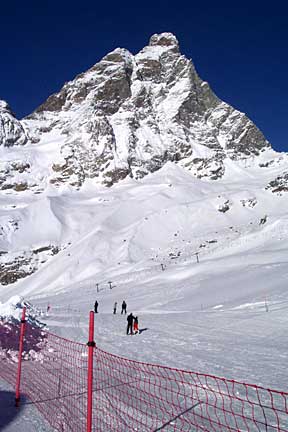
A pleasant two-hour drive from Milan in good weather, Valtournenche is a small, humble and – I’m reluctant to say – sleepy ski village that is situated quite spectacularly in the Valle del Cervino which literally dead ends at the foot of the Matterhorn in Italy’s Valle D’Aosta region.
The Valle D’Aosta is a semi-autonomous region stowed away in the far northwestern corner of Italy where the cultures, cuisines, and quirks of the Swiss, French, and Italians all melt together sort of like the fondue that is a local favorite. The main artery of the region is the A5, which is an East-West-running leg of the famed Autostrada, and off this highway run a handful of perpendicularly oriented veins, each of which meanders up its own valley dead-ending at the Alps.
Located in the heart of town, the Hotel Bijou (an Italian 3-star establishment) offers, for very reasonable rates, clean, though somewhat Spartan accommodations, two entertaining meals a day, and great service from a cast of characters that you cannot help but compare to those who ran Faulty Towers. Lovingly running the Bijou was a man named Basil Faulty… Sorry, a man named Ivo, who was a pleasant and warm – though always slightly harried – chap who did all that he could to meet our every request. The role of Mrs. Faulty was stirringly played by Luigi, a dark, brooding handyman, who at 7am would take our order for that evening’s dinner, at 9am drive us to the ski resort, and at 6pm that night, serve us the dinner he had had a hand in preparing. A man who never looked particularly happy, and who seemed to own only one fleece and one pair of jeans, Luigi was a very dedicated host nonetheless.
Lovingly running the Bijou was a man named Basil Faulty… Sorry, a man named Ivo, who was a pleasant and warm – though always slightly harried – chap who did all that he could to meet our every request. The role of Mrs. Faulty was stirringly played by Luigi, a dark, brooding handyman, who at 7am would take our order for that evening’s dinner, at 9am drive us to the ski resort, and at 6pm that night, serve us the dinner he had had a hand in preparing. A man who never looked particularly happy, and who seemed to own only one fleece and one pair of jeans, Luigi was a very dedicated host nonetheless.
As for the true stars of the hotel, the Bijou offered up two young ladies for these parts. First, there was the lovely Erica, the friendly young brunette who chit-chatted with all the guests in her customary white waitress’s outfit at breakfast and in her more formal black attire for dinner. She was a hit with all, especially the German men, and skillfully played the role of Faulty Towers’ seductive Polly

Then there was Silvia, who completed the quartet and played the role of Manuel. A whiz serving breakfast and dinner delicacies enlisting the classic two-upturned-spoon technique, Silvia greeted guests each day with a different haircut and what appeared to be a new or newly placed piercing. Silvia’s fashion statements seemed to echo the overall theme of the Bijou, for though they were always just slightly amiss, they were at all times strangely warm and appealing.
That being said, no matter how wonderful the staff, it is the masterpieces that emerge from the kitchen of the Hotel Bijou that guests remember most. And after nearly a week’s meals, I left believing that the term "la cucina tipica valdostana" truly meant, "tastes like tuna." 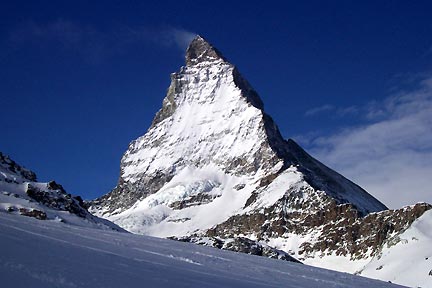
While tuna seemed to be the flavor del viaggio, other Bijou culinary highlights worthy of note included the daringly- undercooked pinwheel sausage, the fondue which turned out to literally be a two-pound pot o’cheese and nothing else, the famed fresh local trout, which must have hiked from the mountain lake two miles away to the Bijou’s kitchen to have acquired so aged a flavor, served with golden mayonnaise, and perhaps most entertaining of all, the mystery meat, which on the menu that had been penned in Italian, German, and English began its journey as agnelli, and ended up on my platter as pork. These culinary encounters helped to bond Bijou guests together, and as an Italian dining partner was able to convey to me despite our distinct language barrier, “With enough wine – even not-so-good wine – the food is perfectly edible!”
Oh yeah, about the skiing… it’s fabulous! Staying in Valtournenche offers you easy access to three world-class resorts, Valtournenche, Breuil-Cervinia, and Zermatt. All three are conveniently connected. Nearest to the Hotel Bijou, Valtournenche offers 7 lifts (T- and J-bars are included in Italy), 15+ runs, and endless expanses of snow. Unlike the resorts of Lake Tahoe in California I grew up on, there are no trees to define the edges of trails here, and instead, the width of each run is decided by the stinginess or generosity of the guy who drove the snow groomer that morning.
If you were to go for a week-long ski trip, Valtournenche, with its spectacular vistas of beautiful rock formations, the fog-shrouded Valle del Cervino below, and the towering Alps all around, would be the place to ski on the first day to find your groove and to get acquainted with Italian ski conditions, and the place to ski for the afternoon of the last day to ensure that you left the Alps on a good note. For the most difficult runs here would be considered only solid intermediates in the States.
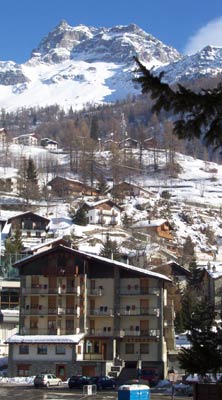
The big brother of Valtournenche, Breuil-Cervinia, skirts the backside of Cervino, which is how the Italians lovingly refer to the Matterhorn. This huge resort offers nearly 200 km of trails, dozens of lifts and gondolas, around 60 runs, access to Switzerland, and absolutely stunning views of said Matterhorn and the adjacent peaks.
A Scotsman I met over lunch on the mountain noted, “Italians like to look good while they ski. They’re all about the style, and far less concerned about the difficulty of the runs they go down. They like to stick to the perfectly groomed stuff, and tend to stay on-piste far more than say, the French.” Breuil-Cervinia is a testament to this Italian ski philosophy, with its infinite supply of perfectly groomed snow, and countless numbers of highly skilled Italians carving their way down the slopes.
Thanks to ever-present glacial snow, skiing takes place at Breuil-Cervinia year-round, though it would be hard to beat skiing there on a bright, sunny day in January when the snow is deep and everything is breathtakingly white. The elevation at the top of the lifts here reaches around 13,000 feet, and with runs that offer vertical drops pushing 4,000 feet, 30-minute chases from top to bottom are not uncommon.
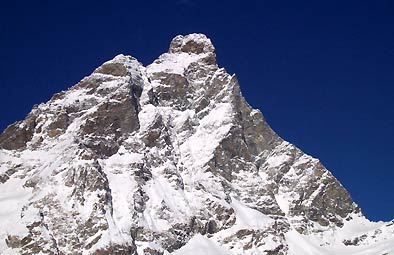 Moreover, a plethora of privately-run ski chalet restaurants serving delicious local fare dot the mountain, though be warned, after you have eaten at these places, you will never be able to look at that overcooked, formerly frozen patty of gray meat, that is so often the standard lunch at U.S. resorts, the same way again.
Moreover, a plethora of privately-run ski chalet restaurants serving delicious local fare dot the mountain, though be warned, after you have eaten at these places, you will never be able to look at that overcooked, formerly frozen patty of gray meat, that is so often the standard lunch at U.S. resorts, the same way again.
The third and final jewel of this alpine triple crown is world-renowned Zermatt in Switzerland. Accessible by hiking, biking, or a number of roads in summer, Zermatt is (with the exception of one or two long mountain tunnels), only accessible from Italy in winter by skiing. Undoubtedly, Zermatt showcases the most spectacular views and skiing of the bunch, for whereas you ski in the shadow of the Matterhorn at Breuil-Cervinia, you ski on the Matterhorn at Zermatt. Awe-inspiringly stunning views of the Gornergletscher (the scale of which cannot be done justice in a photograph), Mount Rose, and of course, the Matterhorn, as well as spectacular, though hair-raising gondola flights 400-500 feet above jagged cliffs and the chamois that call them home, make the skiing seem like an afterthought, though the wonderfully long runs (read: 40-minute journeys), trails that are surprisingly manageable, and perfect snow conditions, all serve to remind you why you came to Zermatt in the first place.
If you expect the Swiss to have a super efficient system for getting from one side of the resort to the other, you will be terribly disappointed. Anticipate hiking a considerable distance through the streets of Zermatt (if you miss the signs for the ski bus as we did), and be prepared to traipse through at least one Landtunnel. Despite this shortcoming, Zermatt is truly an unforgettable place to ski. Just be sure to be back up to the top of the mountain before the lifts stop running for the day, or else you will be looking at an unexpected night’s stay in Switzerland.
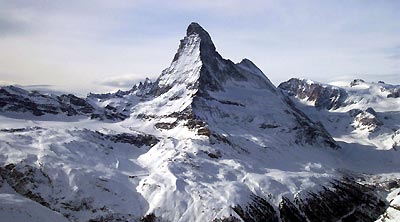
In the end, perhaps the Italians truly do know how to live la dolce vita, for they stay in Valtournenche or Breuil-Cervinia, and ski at Valtournenche and Breuil-Cervinia, leaving Zermatt (and the 4-lift/gondola hassle that is required to crest the peak to ski over), and the rest of Switzerland for that matter, to the Swiss, the chamois, and the tourists). They know all too well that Valtournenche has it all: world-class skiing, a gorgeous Alps setting, jaw-dropping views, and perhaps most notably, the wonderful Hotel Bijou, where adventurous souls can enjoy the bold and incomparable la cucina tipica valdostana.
seductive Polly.
uon appetito.”
